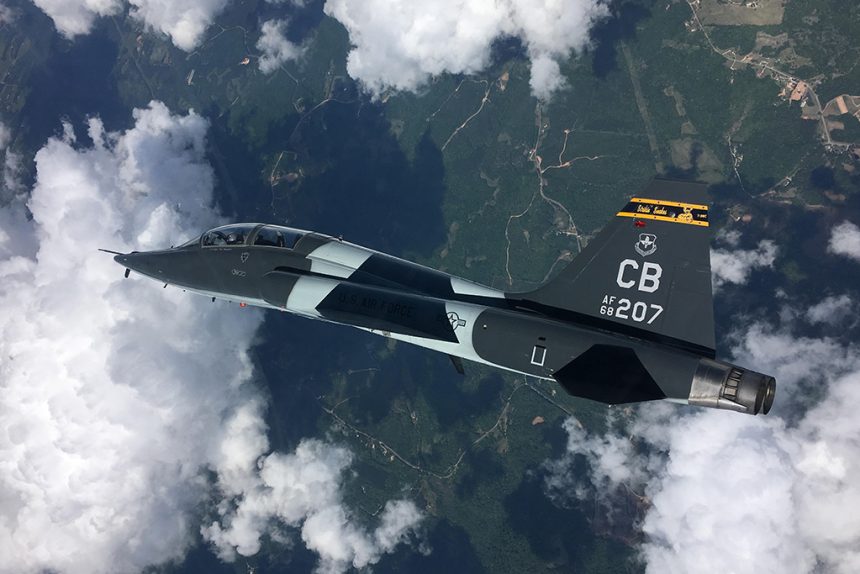In April 2016 we visited 14th Flying Training Wing at Columbus AFB, Mississippi. Here’s our report.
In an era when unmanned flying is becoming a normality, the U.S. Air Force is expanding its pilot training pipeline to overcome an insatiable demand for experienced pilots for both cockpit and staff positions. This demand, combined with newly increased competition for military pilots from commercial airline recruiters, has led to a shortage of Air Force fighter pilots. The USAF is now forced to grow its pilot production on the back of an aircraft that is decades old and has little room to modernize—all while the service is prioritizing a new generation of remotely piloted aircraft operators.
On a beautiful April day of 2016, we were invited to visit Columbus Air Force Base which is the home of the 14th Flying Training Wing of Air Education and Training Command’s (AETC) 19th Air Force. The base is located five miles north of the city of Columbus in Lowndes County, Northeast Mississippi, ten miles west of the Alabama state border. Columbus AFB is the base of the 14th Flying Training Wing, along with the 14th Mission Support Group, 14th Mission Support Group and the 14th Operations Group. The aircraft operated by the 14th FTW are the 57 year-old T-38 “Talon”, the Beechcraft T-6 “Texan II” and the T-1A “Jayhawk”. At the time of our visit the base was assigned the most aircraft of any in the USAF, 234 in total. These aircraft based at Columbus AFB flew an average of 53,514 sorties per year, requiring 2,492 people to operate the base and its facilities. This staff is further divided into 1,447 Military personnel; 554 civilians; 522 Contractors and 143 other professionals. All of this manpower and effort produces an average of 475 students trained annually, the highest in the USAF.
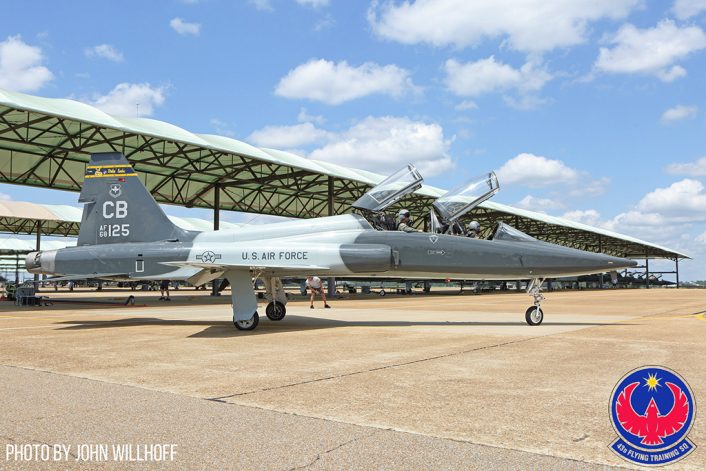
History
Columbus AFB has been training US pilots since World War II, and that mission continues today. The base closed after the war and remained inactive until 1951 when it was reopened as a contract flying school to train pilots during the Korean War. Four years later, the base was transferred from Air Training Command to Strategic Air Command (SAC). Columbus became home to a SAC strategic wing with a KC-135 Stratotanker tanker squadron and a B-52 Stratofortress bomber squadron in the late 1950s. This wing was later redesignated a bombardment wing in the 1960s. In 1969, the SAC bomber mission at Columbus was inactivated and the base was transferred back to the then-Air Training Command as an Undergraduate Pilot Training (UPT) base. Columbus AFB then resumed the mission for which it originally activated – training pilots, and has continued to do so for the past 40 years. About half the pilots in the Air Force today went through basic and primary flight training at Columbus AFB.
Produce Pilots, Advance Airmen, Feed the Fight.
The 14th FTW mission statement is “Produce Pilots, Advance Airmen, Feed the Fight.” The wing’s mission is specialized undergraduate pilot training in the three types of aircraft on hand, the T-6,T-1A and T-38C.
In the primary phase of training, students fly the T-6. The emphasis throughout this phase is on basic aircraft control, including takeoff and landing techniques and aerobatics. Students also learn to use aircraft instruments to fly and navigate in all types of weather to several different locations.
Following the T-6 phase of training, student pilots enter specialized track specific training-depending on the type aircraft they’ve been selected to fly – T-38 for those bound for fighter and bomber aircraft or the T-1A for tanker and airlift pilots. Student pilots selected to fly helicopters conduct their training with the U.S. Army at Fort Rucker, Alabama.
To earn Air Force wings, each student flies nearly 200 hours during a 54-week period. Along with flying training, students complete 400 hours of flight-related classroom instruction. Students entering training at Columbus average 475 officers a year.
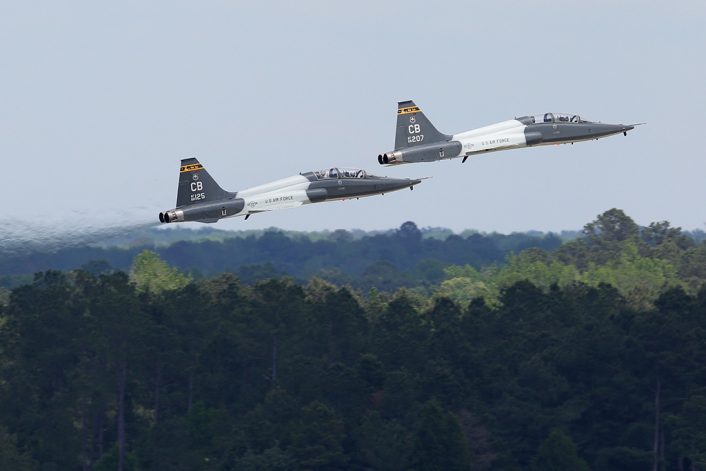
Pilots in Specialized Undergraduate Pilot Training (SUPT) at AETC go through four phases: Introduction to Flight Training, Preflight Training, Primary Flight Training, and Advanced Flight Training.
The first phase is largely procedural training, with 18 hours of flight. In the next two phases, a pilot flies 86.6 hours in a T-6A Texan II, plus 45.7 simulator hours. In the last phase, pilots move on to specialized airframes for advanced flight. Mobility pilots, for example, fly 77.7 flight hours in a T-1A Jayhawk, focusing on refueling and airdrops, with 53.6 simulator hours. Fighter pilots fly 95.5 hours in a Talon and 39.5 hours in a simulator.
The fighter pilots rely heavily on simulators because of the T-38’s shortfalls in advanced training. The process is broken down into 18 tasks, and 12 of those need simulation because of the gaps in capability of the T-38. The areas where the T-38 is up to the task are basic air-to-ground training, basic cockpit resource management, preparation and planning, mission debrief, energy efficiency, and human systems integration.
The Talon
While the T-38C is old, and it has its limitations, the appeal of the world’s first supersonic trainer is undeniable. According to Northrop, more than 72,000 US Air Force pilots have trained in Northrop Grumman Corporation’s T-38 Talon, and many more aviators have flown in it. Nearly 1,200 Talons were produced from 1961-72, and more than 500 are currently operational with the Air Force and NASA. Northrop Grumman Corporation has produced a replacement wing for the T-38 that will help to extend the service life of the aircraft, introduced in 1961, until at least 2020. By then the USAF’s replacement trainer, the “T-X” should have a name.
No matter how long the T-38 remains in service, it’s just one of those cool looking, memorable aircraft whose legacy will go on indefinitely. We were lucky to be invited to fly a mission with the pilots of the 50th Flying Training Squadron.
In preparation of this mission, we interviewed former USAF pilots who had the opportunity to train in the Talon. Every single one expressed an enthusiastic admiration for the aircraft, many ranking it as the favorite airplane they ever flown.
We were about to find out why.
“Pistol flight”
Around noon we met Major Joshua “P-Row” Parnell, our pilot for today’s mission. We grabbed a quick lunch where we went over the plan for the day. Maj Parnell is a reservist – but on “full time” status. He grew up near the Air National Guard base in Fort Smith, AR and as a kid, loved to watch the F-4 Phantoms fly over his house. His uncle, who was an aircraft mechanic, took him out to the base several times to watch the airplane operations, and it didn’t take much for him to get hooked. He quick realized that flying was the only thing he wanted to do. “P-Row” spent 10 years enlisted as an F-16 crew chief / aircraft mechanic at Fort Smith, Arkansas, graduating basic military training 1994 and leaving the enlisted ranks as SSgt in 2004. when was commissioned as Second Lieutenant (2LT). He then graduated SUPT at Laughlin AFB, TX in 2006, spending 5 years tour as KC-135 pilot at Sioux City, Iowa. Following that tour, he transitioned to the A-10, spending another 5 years at Fort Smith, Arkansas. Maj Parnell has spent the last two years in the USAF Reserve at Columbus, Mississippi as T-38 instructor pilot.
After lunch we were instructed in the standard operational and emergency procedures for the T-38. After this class we were familiarized with the Martin baker MK 16, the ejection seat equipping the T-38. At 1300 we met up in the Squadron’s briefing room with Lt Col (O-5) Tom “Punch” Kisio, the flight lead for our training mission. Lt Col Kisio is a former F-16 pilot and the Squadron Assistant Director of Operations.
The objectives of the mission were Instructor proficiency with focus on maintaining close formation, rejoins in less than 120° of turn and Perch set-up range calls within 500ft. The mission profile planned called for a formation take-off, Tactical – Line (1 mile apart), wing work and perch set-ups/extended trail (what resemble the beginning of a fight). Call sign for the flight was “Pistol.”
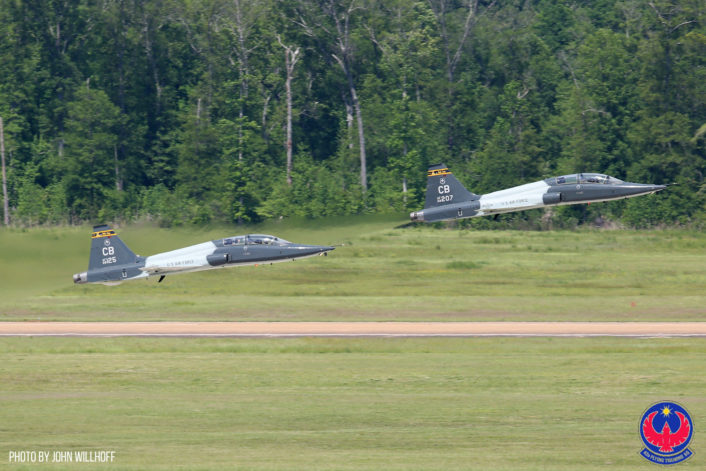
As we approach aircraft AF 68125, we start with a walkaround inspection. Access to the T-38 cockpit is usually gained by use of a sturdy ladder that hooks over the edge of the canopy. Maj Parnell helps me strap in. After taking his place in the front cockpit he turned on the battery, checked the fuel and oxygen quantity, landing gear lights, and cockpit warning light, before turning the batteries back off. His final pre-start item was to check the aircraft’s maintenance forms to ensure the plane was ready to fly. Everything looks good, we are ready to go. As the T-38 has no self-start capability, it needs a supply of pressurized air to rotate the engines. This air is supplied by a “huffer” unit or palouste, which is connected via a large hose to a manifold on the bottom of the airplane, near the left engine. During start, the ground crewman must manually switch the air to the other engine after the first one is started. When you are ready to start, you give the crew chief the “air” signal by raising your arms over your head, making a fist with your left hand and slamming it into your right palm.
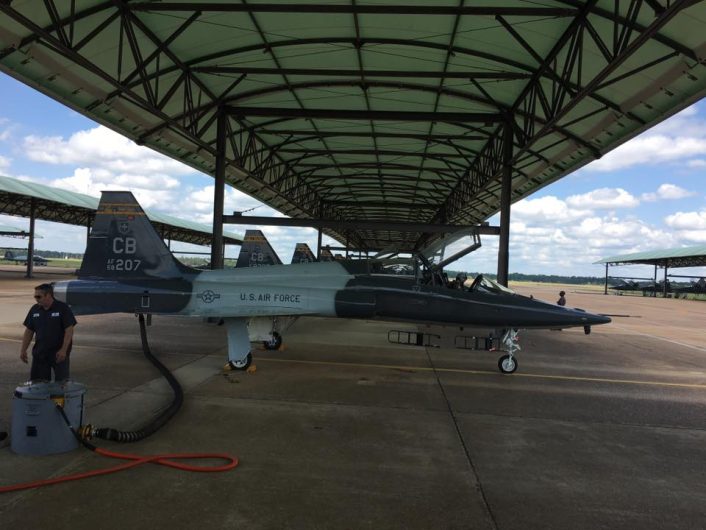
Once the engines are started and checklist are completed, the T-38’s nosewheel steering system is activated by holding down a rather stiff button at the base of the stick. As you add power to start rolling forward, you squeeze the button hard. Full pedal deflection turns you smartly away from the parking spot, and you check the heading indicators to make sure they’re turning. While taxiing out to the runway, you review the Takeoff and Landing Data (TOLD), which you wrote on your kneeboard card before leaving the squadron’s Operations building. Specifically, you look at four numbers and commit them to memory: The Minimum Acceleration Check Speed (the speed at which you should be traveling when you are a certain distance down the runway, usually 2000 feet. This number validates all the other numbers, and ensures you have a normally-performing airplane); the Go/No-Go Speed (where you decide to continue the takeoff or abort); the Refusal Speed (the highest speed you can attain and still theoretically stop in the remaining runway length); and the Single-Engine Takeoff Speed (the minimum speed you need in order to take off after an engine failure.) Such cautiousness is required by the military’s many years of operational experience with the Talon, and from the experiences of many pilots no longer with us — whose ignorance of these numbers lead to their demise.
We are at the end of the runway. Tower clears us for takeoff. You reach up with your left hand and grab the edge of the canopy frame, lift it slightly, then pull it down as your right hand moves the right sidewall-mounted locking lever forward. The canopy locks with a satisfying clunk, and the red “Canopy” light on the instrument panel extinguishes. Almost immediately, you feel a slight “fullness” in your ears as the cabin pressurization system goes to work. Taxiing into position on the runway, you turn on the pitot heat and transponder, and check the heading system again. Now the fun begins.
Immediately after liftoff, “P-Row” raises the gear and flaps to avoid over-speeding them. More acceleration, 240 knots comes quickly. The idea is to keep the nose low, only 3 or 4 degrees high, until 300 knots, then raise the nose to 12 degrees to keep the speed at 300-knots. At this point your altimeter begins a rapid upward climb.
We leveled off at 16,000 feet in our designated practice area, and “P-row” checks the oxygen system, pressurization, fuel quantity and balance, G-suit and altimeter. Everything looks good, so it is time to have a little fun. “P-Row” and “Punch” get down to business very quickly. Quick aileron turns, close formations, chases, simulated aerial engagements. Surely fun for the passenger!
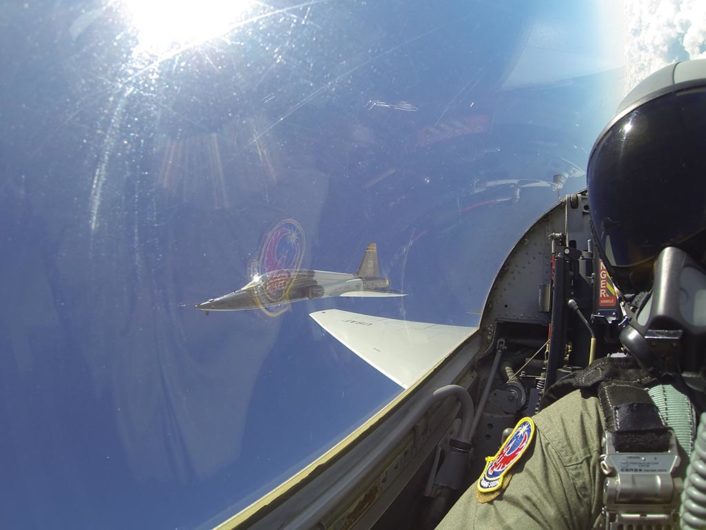
The T-38 can be flown throughout its performance envelope, from aerobatics to the landing pattern, with barely any use of the rudder. With the landing gear retracted, only 6 degrees of rudder deflection is available, and in the landing configuration, 30 degrees is available.
Like an arrow, the Talon goes where it is pointed, not where it is banked. This means that turns are accomplished by banking in the desired direction (thus placing the lift vector where the plane needs to go) and pulling the nose to the desired point. To lower the nose to gain airspeed for an aerobatic maneuver, it is simpler and more comfortable to roll the plane upside down, pull the nose down to the desired pitch, then roll it upright again.
At the end of the planned training exercise Lt Col Kisio leads “Pistol” flight back to Columbus AFB to for a runway 13 landing.
The “overhead” landing pattern is entered from the initial, then an upwind leg over the runway at 1,500 feet and 300 knots. At midfield, you crisply roll into a 65 to 70-degree bank and pull the airplane around a 180-degree turn, losing 70 knots of airspeed and arriving on the downwind leg with approximately half-mile spacing from the runway. Abeam the desired point of landing, you lower the landing gear and flaps, then push the power up to maintain around 200 knots. At the “perch” point, 45 degrees past the runway threshold, you roll into a 45-degree banked turn, lower the nose about 5 degrees, and begin pulling the airplane around the final turn. The T-38 has an unusual airframe buffet at its optimum final-turn Angle of Attack (AOA). New Talon pilots must develop a feel for this phenomenon, and must cross-check their airspeed, AOA and vertical speed carefully to avoid developing a dangerous sink rate during the final turn. Once established on final, you adjust your speed to 155 knots, plus one knot for every 100 pounds of fuel in excess of 1,000 pounds. For example, with 2,500 pounds of fuel on board, the desired final approach speed is 155+15, or 170 knots. This speed is adjusted upward for gusty winds, or no-flap configurations. (The speed for no-flap approaches is 170 knots, plus the additions mentioned above.)
Back at the parking area, the Crew Chief places chocks around our main tires, and signals for shutdown. Maj Parnell releases the throttle gate, pulls up on the finger-lifts, and moves the throttles to the “cutoff” position. As the engines spool down to a graceful stop, you take off your helmet to let the warm breeze blow across your face, reflecting on what a fantastic experience it was!
The End of an Era
The Talon is truly one of the great airplanes of our time. It is a timeless beauty, and has performed superbly for over almost six decades as an advanced trainer in several air forces around the world, as well as a test support vehicle, chase ship, companion/proficiency trainer, light attack/fighter trainer, airshow performer, and privately-owned “personal rocketship”. While not a complex or difficult airplane to fly, it nevertheless has some unique flight characteristics that demand absolute precision and discipline from its pilot.
The fighter pilots of tomorrow get the bulk of their training in a cockpit built to train pilots in the early 1960s. Raptor and Lightning II drivers are training in the same jets used to train F-4 drivers. With the importance being placed on the acquisition of the T-X, that will not be the case for too many more years.
The author would like to thank Lt Col Kirby “Gat” Ensser, Commander, 41st Flying Training Squadron, Maj Erik Dofelmier, Maj Robert Young, SrA Stephanie Englar and 2nd Lt. Carlos Monge for the hospitality during our visit.
A slightly different version of this article was published in Combat Aircraft June 2017 issue.
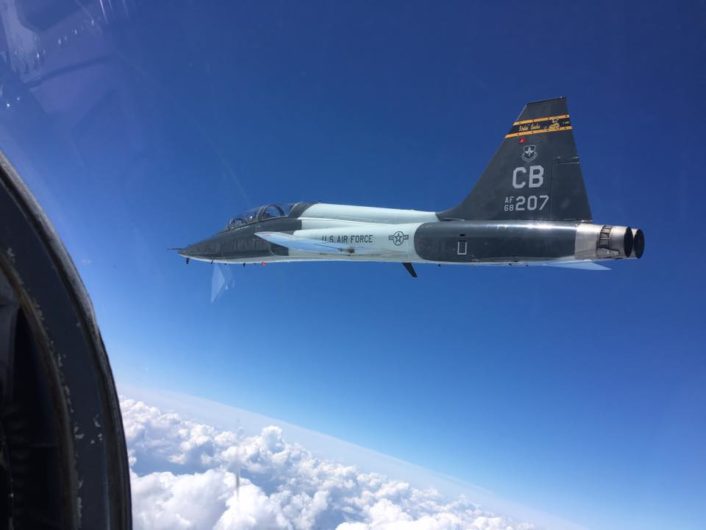
Editor note: as mentioned in the article, the report was written back in 2016. At the end of September 2018, the U.S. Air Force has awarded Boeing USD 9.2 billion for the development of the new trainer and supporting systems: the T-38 Talon jets will be replaced by the Boeing T-X built in cooperation with Saab. On Nov. 14, 2018, a USAF T-38C advanced jet trainer from Laughlin AFB crashed killing one pilot (the other one was hospitalized). The incident was the fifth T-38 accident for the Air Force this year. Click here to read the reports we wrote after the previous crashes.

